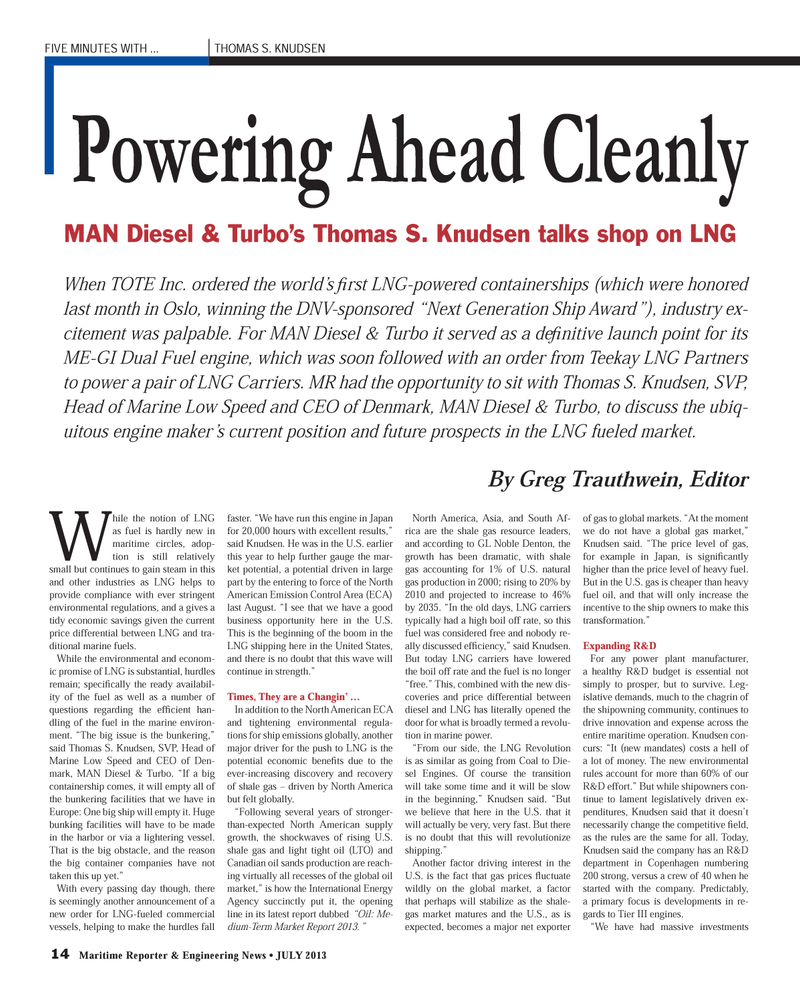
Page 14: of Maritime Reporter Magazine (July 2013)
Maritime Security Edition
Read this page in Pdf, Flash or Html5 edition of July 2013 Maritime Reporter Magazine
14 Maritime Reporter & Engineering News ? JULY 2013 While the notion of LNG as fuel is hardly new in maritime circles, adop-tion is still relatively small but continues to gain steam in this and other industries as LNG helps to provide compliance with ever stringent environmental regulations, and a gives a tidy economic savings given the current price differential between LNG and tra- ditional marine fuels.While the environmental and econom-ic promise of LNG is substantial, hurdles remain; speciÞ cally the ready availabil- ity of the fuel as well as a number of questions regarding the efÞ cient han- dling of the fuel in the marine environ-ment. ?The big issue is the bunkering,? said Thomas S. Knudsen, SVP, Head of Marine Low Speed and CEO of Den-mark, MAN Diesel & Turbo. ?If a big containership comes, it will empty all of the bunkering facilities that we have in Europe: One big ship will empty it. Huge bunking facilities will have to be made in the harbor or via a lightering vessel. That is the big obstacle, and the reason the big container companies have not taken this up yet.?With every passing day though, there is seemingly another announcement of a new order for LNG-fueled commercial vessels, helping to make the hurdles fall faster. ?We have run this engine in Japan for 20,000 hours with excellent results,? said Knudsen. He was in the U.S. earlier this year to help further gauge the mar- ket potential, a potential driven in large part by the entering to force of the North American Emission Control Area (ECA) last August. ?I see that we have a good business opportunity here in the U.S. This is the beginning of the boom in the LNG shipping here in the United States, and there is no doubt that this wave will continue in strength.?Times, They are a Changin? ? In addition to the North American ECA and tightening environmental regula-tions for ship emissions globally, another major driver for the push to LNG is the potential economic beneÞ ts due to the ever-increasing discovery and recovery of shale gas ? driven by North America but felt globally. ?Following several years of stronger- than-expected North American supply growth, the shockwaves of rising U.S. shale gas and light tight oil (LTO) and Canadian oil sands production are reach-ing virtually all recesses of the global oil market,? is how the International Energy Agency succinctly put it, the opening line in its latest report dubbed ?Oil: Me-dium-Term Market Report 2013.? North America, Asia, and South Af- rica are the shale gas resource leaders, and according to GL Noble Denton, the growth has been dramatic, with shale gas accounting for 1% of U.S. natural gas production in 2000; rising to 20% by 2010 and projected to increase to 46% by 2035. ?In the old days, LNG carriers typically had a high boil off rate, so this fuel was considered free and nobody re-ally discussed efÞ ciency,? said Knudsen. But today LNG carriers have lowered the boil off rate and the fuel is no longer ?free.? This, combined with the new dis- coveries and price differential between diesel and LNG has literally opened the door for what is broadly termed a revolu-tion in marine power. ?From our side, the LNG Revolution is as similar as going from Coal to Die-sel Engines. Of course the transition will take some time and it will be slow in the beginning,? Knudsen said. ?But we believe that here in the U.S. that it will actually be very, very fast. But there is no doubt that this will revolutionize shipping.?Another factor driving interest in the U.S. is the fact that gas prices ß uctuate wildly on the global market, a factor that perhaps will stabilize as the shale-gas market matures and the U.S., as is expected, becomes a major net exporter of gas to global markets. ?At the moment we do not have a global gas market,? Knudsen said. ?The price level of gas, for example in Japan, is signiÞ cantly higher than the price level of heavy fuel. But in the U.S. gas is cheaper than heavy fuel oil, and that will only increase the incentive to the ship owners to make this transformation.?Expanding R&DFor any power plant manufacturer, a healthy R&D budget is essential not simply to prosper, but to survive. Leg-islative demands, much to the chagrin of the shipowning community, continues to drive innovation and expense across the entire maritime operation. Knudsen con-curs: ?It (new mandates) costs a hell of a lot of money. The new environmental rules account for more than 60% of our R&D effort.? But while shipowners con- tinue to lament legislatively driven ex-penditures, Knudsen said that it doesn?t necessarily change the competitive Þ eld, as the rules are the same for all. Today, Knudsen said the company has an R&D department in Copenhagen numbering 200 strong, versus a crew of 40 when he started with the company. Predictably, a primary focus is developments in re-gards to Tier III engines. ?We have had massive investments Powering Ahead Cleanly MAN Diesel & Turbo?s Thomas S. Knudsen talks shop on LNG When TOTE Inc. ordered the world?s Þ rst LNG-powered containerships (which were honored last month in Oslo, winning the DNV-sponsored ?Next Generation Ship Award?), industry ex- citement was palpable. For MAN Diesel & Turbo it served as a de Þ nitive launch point for its ME-GI Dual Fuel engine, which was soon followed with an order from Teekay LNG Partners to power a pair of LNG Carriers. MR had the opportunity to sit with Thomas S. Knudsen, SVP, Head of Marine Low Speed and CEO of Denmark, MAN Diesel & Turbo, to discuss the ubiq- uitous engine maker?s current position and future prospects in the LNG fueled market. By Greg Trauthwein, Editor FIVE MINUTES WITH ...THOMAS S. KNUDSENMR #7 (10-17).indd 14MR #7 (10-17).indd 147/2/2013 8:59:20 AM7/2/2013 8:59:20 AM

 13
13

 15
15
